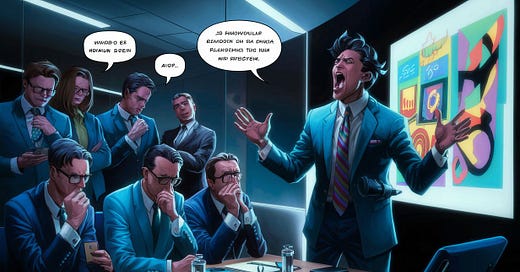My secret to pitching design solutions effectively
Never again hear the words "let's try to target this in the next sprint"
Most courses, curricula, resources, and articles would advise a product designer to build a quotient for user-centered design, to master the skill of mapping user needs into a seamless experience. My hot take is that, while this the right approach, your pitch must never begin with that. In this article, I will shed light on my philosophy when it comes to pitching solutions to my clients, team, and c-suite management that hits the mark 9 times out of 10.
Prompt: A captivating indie comic panel depicting a passionate designer, dressed in a sharp suit, pitching his innovative solutions to a board of directors. He is speaking a foreign language, making it incomprehensible to the audience. The audience members, dressed in formal attire, appear disinterested and confused, engaged in hushed conversations amongst themselves. One director is seen yawning, while another checks their phone. The designer, oblivious to the audience's behavior, continues to gesticulate animatedly, unaware of the lack of engagement. The scene is set against the backdrop of a modern, sleek conference room, with the designer's bold, colorful designs displayed on a projector screen.
Users don’t exist outside of a business
Every product designer reading this article will most probably work on a product that *has* to generate revenue or aid in processes to generate revenue. User experience in its core form isn’t needed for philanthropic avenues. Especially in this dog-eat-dog market, the experiences you craft and refine will decide whether or not your product stays in business. So when your solutions favor the simplicity of user requirements over the urgency of business north stars, you will face pushback. Explicitly stating how your designs aid the business while assuring that user needs are fulfilled as a by-product is how you get your C-suite to listen to you.
Speak the language of monetary value
Your clients/stakeholders do not need you, period. UI is a commodity and for most start-ups focussing on UXD is an important but expensive moat. So now imagine where you’re pitching your ideas to your manager who then has to get approval from upper management. You’ve designed this spotless flow with all the consistent and latest UI trends while keeping in mind what the user wants. Essentially, your pitch can be summarized as “This flow will make it easier for the user to carry out X task”. What about the business? Will this flow make it easier for businesses to build a profitable funnel? It might but you never said that. You were busy explaining gestalt principle to someone who’s been worrying about churn rate of this quarter. Pitching solutions in a way that your audience, essentially people in charge of running the company, understands the monetary value it brings to the table will get quicker sign-offs and green signals.
Going beyond UX
Product Designers don’t necessarily need to learn how to code but a designer with a quotient for business is an unignorable force of this ecosystem. You start seeing design as a medium to solve business problems and a quality of this stature rarely goes unnoticed by people who call the shots. You don’t need an MBA; you just foundationally need to understand the business jargons and frame your solutions in revenue metrics. It is with experience and some diligent research; that you will truly start understanding what the business needs and begin envisioning solutions via UX design.
Frame for good.
I was introduced to this framework very early in my career and it has served me greatly. Frame for good essentially means that before you pitch your solution you showcase what the right solution looks like. You use existing solutions, possibly your competitors, or ever product from a different category altogether. The thing of the essence is that you get your buy-ins for a reference of a successful solution before you unveil yours. This gives the people listening to you a frame of reference to map the credibility of your solutions. A frame for good if you will.
It is all about how you narrate your value proposition. You might be the best designer your company/client has ever seen but it would mean nada to them if they couldn’t visualize the value in your designs. So speak their language, go beyond UX, and frame for success.





